Can You Draw Barricade in Your Opening Hand
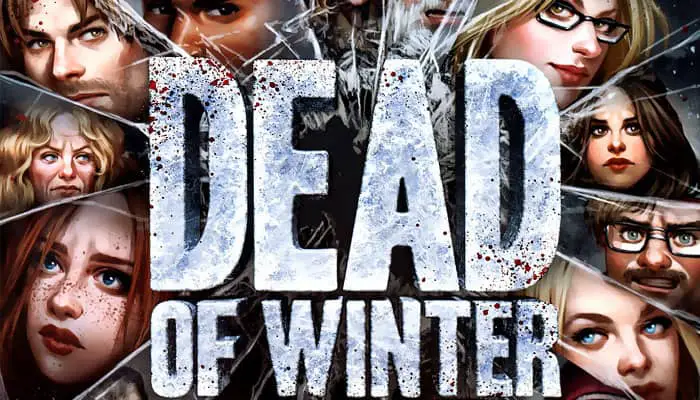
Game Components

- 10 Dual-Sided Main Objective Cards
- 24 Secret Objective Cards
- 10 Betrayal Secret Objective Cards
- 10 Exiled Secret Objective Cards
- 30 Survivor Cards
- 5 Player Reference Sheets
- 1 First Player Token
- 25 Starting Item Cards
- 20 Crisis Cards
- 80 Crossroads Cards
- 25 Wound Tokens
- 6 Starvation Tokens
- 2 Track Markers
- 20 Police Station, Grocery Store, School Item Deck Cards
- 20 Gas Station, Library, Hospital Item Deck Cards
- 20 Helpless Survivor, Food, Noise, Barricade Tokens
- 30 Zombie Standees & Survivor Tokens
- 60 Plastic Standee Stands
- 1 Colony Board
- 6 Location Cards
- 1 Rulebook
- 30 Action Dice
- 1 Exposure Die
Setup
Place the colony board in the center of the play area and place the 6 location cards around it as shown or as best accommodates your table. Each player collects a player reference sheet.

Players may decide which standard main objective they would like to play or pick 1 randomly. Place the main objective card in its space on the colony board and set up the game board according to the main objective's setup instructions.
Shuffle the non-betrayal secret objective cards and set aside 2 (facedown) per player. Return the rest of the non-betrayal cards to the game box. Shuffle the betrayal secret objective cards and add 1 of them (facedown) to the non-betrayal cards that were set aside. Return the remainder of the betrayal secret objective cards in the game box. Shuffle all of the set aside cards together and deal 1 to each player. Return the remaining secret objective cards to the game box without looking at them. A player cannot reveal his secret objective card to other players.
Shuffle the crisis cards and place the deck on its space on the colony board. Shuffle and make decks of the survivor, exiled objective and crossroad cards and place the decks off to the side of the play area.
Important Note: Some crossroads cards have mature themes like sex, language, suicide, alcohol use, etc. These cards are marked with this symbol. Players may choose to remove these cards prior to the game.
Shuffle all of the starter item cards and deal 5 to each player. Return any remaining cards to the game box. Separate the remaining item cards into separate decks according to their location. Shuffle each deck and place it on its corresponding location card.
Deal 4 survivor cards to each player. Each player then chooses 2 to keep and returns the others to the deck. Re-shuffle the survivor deck. Each player makes 1 of those 2 survivors her group leader, placing it in the respective space on her reference card.
The other survivor is placed in the player's following, below their player reference sheet. The corresponding survivor standees for each player's survivors are added to the colony.
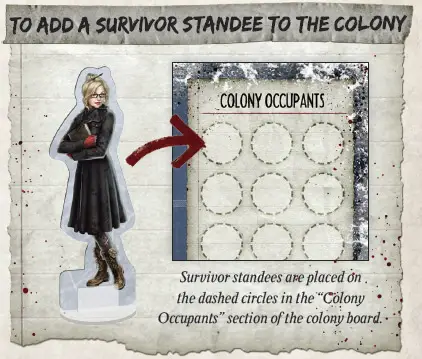
Separate the remaining standees and tokens placing them within easy reach of all players. The player whose group leader has the highest influence value receives the first player token and will take the first turn of the game.
Object of the game
In Dead of Winter, players are a colony of survivors trying to survive a hazardous winter in the aftermath of the zombie apocalypse. The colony has an objective they are trying to complete, but each player also controls a group of survivors that has a secret objective.
Often this secret objective requires that a player help complete the colony objective. Only players who have completed their secret objective when the game ends will win.
The game can end in a variety of ways: If the morale track reaches 0, if the round track reaches 0, or if the main objective is completed.

Game Play
Dead of Winter is played over a series of rounds. Each round is divided into 2 phases that must be played in order:
- I. Player Turns Phase
- II. Colony Phase
I. Player Turns Phase
During the player turns phase resolve the following 3 effects in order.
1. Reveal Crisis
Reveal the top card of the crisis deck. This card's effect will take place during the colony phase if it is not prevented. Crisis cards can be prevented if players contribute enough of the correct type of cards to that crisis.
2. Roll Action Dice
At this time each player removes any action dice remaining in her used and unused action dice pool. Then each player receives 1 action die, plus 1 additional action die for each survivor she controls (so players will start the game with 3 action dice). Each player must roll all of her action dice and keep the results in her unused action dice pool for use during her turn. Even though a player receives 1 action die per survivor she controls, the action die does not belong to that survivor, but to that player's group of survivors. A player can spend multiple action dice on performing multiple actions with a single survivor.
3. Player Turns
During the player turn phase, each player starting with the first player will take a turn. At the beginning of a player's turn the player to her right draws a crossroads card (applying its effects to the player taking the turn if, at anytime during that turn, they meet the trigger requirement). On a player's turn she may perform multiple actions.
Once a player has performed all of the actions she wishes (or if she runs out of actions she is able to perform) on her turn, play passes to the player on her left.
Play will continue clockwise around the table until each player has taken a turn. Once each player has taken a turn the player turns phase is over and the colony phase begins.
Player Turn Actions
Some actions require spending an action die and others do not. To spend an action die, a player removes the appropriate die from his unused action die pool and moves it to his used action die pool. Some actions require that the action die be a specific result (from having rolled it during the roll action dice step).

Actions that require an Action Die
Attack
To perform an attack, a player must choose a survivor he controls and spend an action die equal to or higher than the attack value of that survivor. That player may then choose a target for that attack. The target must be a zombie or a survivor that shares a location with the attacking survivor.
If a zombie is chosen, kill it and remove it from the game board. Roll for exposure on the survivor that attacked.
If a survivor is chosen, roll the spent action die. If the result is equal to or less than the chosen survivor's attack value place a wound marker on the chosen survivor and take a card at random from the hand of the player that controls that survivor.
Note: The exposure die is not rolled when attacking another survivor.

A player may attack multiple times with the same survivor in a single turn. An action die equal to or higher than the attack value of that survivor must be spent each time that survivor attacks. A player cannot have a survivor he controls attack another survivor he controls. A player cannot attack a helpless survivor.
Search

A player can search at any location except the colony. To perform a search, a player must choose a survivor he controls and spend an action die equal to or higher than the search value of that survivor. He may then draw 1 card from the item deck of the location that survivor is on, looking at it but not yet adding it to his hand. He may then choose to either:
- add that card to his hand and end his search action, or
- make noise by placing a noise token on an empty noise space at his location to draw and look at an additional card. He may draw additional cards as long as there are still empty noise spaces for the corresponding noise tokens.
When the player has decided he has made enough noise or can no longer make any more noise, he must keep 1 of the drawn cards, adding it to his hand, and place the rest on the bottom of that item deck. A player may search multiple times with the same survivor in a single turn. An action die equal to or higher than the search value of that survivor must be spent each time that survivor searches.
Barricade
To perform a barricade action, a player must choose a survivor he controls and spend an action die of any result to place a barricade token on any empty entrance space at the chosen survivor's location.
Clean Waste
A player may perform a clean waste action if he controls at least 1 survivor at the colony. To perform a clean waste action, that player must spend 1 action die of any result and remove the top 3 cards of the waste pile from the game.
Attract
To perform an attract action, a player must choose a survivor he controls and spend an action die of any result to move 2 zombies from any location to any empty entrance spaces at chosen survivor's location.
Survivor Ability
Some survivor abilities require an action die to be spent. When this is the case it will be signified by a number in front of the ability's text. The action die spent must meet or exceed that number in order for it to be used. A player may use the same survivor's ability multiple times in a single turn, unless the ability says otherwise. An action die equal to or higher than the ability's number must be spent each time it is used.

Actions that do not require an Action Die
Play a Card
As many times as he likes during his turn, a player may play a card from his hand. To play a card, place it on top of the waste pile.
Reminder: For every 10 cards in the waste pile during the check waste step the colony will lose 1 morale.
A card with an equip ability is not placed in the waste pile, instead a player may equip it to any survivor he controls by placing that card next to that survivor. That survivor now has the effect listed on that item card. Once a card is equipped it cannot be unequipped unless it is being added to a crisis or is being handed off. If a survivor with 1 or more equipped cards dies at the colony the equipped cards are added back to the controlling player's hand.
If a survivor with 1 or more equipped cards dies at a non-colony location the equipped cards are shuffled into that location's item deck. A player can only play cards during his turn.
Add a Card to the Crisis
A player may add 1 or more cards from his hand and/or cards that are equipped to survivors he controls to the currently revealed crisis card. Cards added to a crisis from a player's hand are added face down so that no other player can see them. Adding cards that match a symbol shown in the prevent area of the crisis card helps to prevent that crisis from happening. Each card added that does not match a symbol helps cause the crisis to happen.
Note: Some food cards add multiple food tokens to the food supply when they are played. Those food cards still only count as 1 card played into the crisis.
Move a Survivor
A Player may move each survivor he controls once during his turn. A survivor may be moved to any location that has an empty survivor space. After each time a player moves a survivor, he must roll for exposure.
Note: If the result of rolling for exposure was a bitten, when it is spread it spreads to a survivor in the location that the moved survivor just moved to.
Spend Food Tokens

A player may spend 1 or more food tokens by removing them from the food supply area on the colony board. That player increases any 1 unused action die he controls by 1 for every food token he spends.
Request
During his turn a player may request 1 or more item cards from other players. Other players may give the requesting player an item card from their hand, if they do, that card must be revealed and immediately played. The requested card cannot be added to the crisis.
Hand Off
During his turn a player may have a survivor he controls that has an item equipped hand that item off to another survivor at the same location. When an item is handed off it is unequipped from the survivor that is handing it off and is immediately equipped to the survivor that it is being handed to.
Note: If the item has a once per round ability and it has already been used that round it cannot be used again by handing it off to another survivor.
Vote to Exile
Once during each of his turns a player may choose another player and initiate a vote to exile that player. Initiating a vote forces all players to simultaneously cast a vote of yes (thumbs up) or no (thumbs down) to determine whether or not the chosen player is exiled. A player cannot initiate a vote to exile themselves. Remember all ties are broken by the first player, this includes votes to exile.
Rolling For Exposer
Immediately after a survivor moves to a new location or kills a zombie, the player that controls that survivor must roll for exposure by rolling this die. Each die face has an effect that is triggered when that result is rolled.
Effects
 Blank: Nothing happens.
Blank: Nothing happens.
 Wound: The survivor receives 1 wound token.
Wound: The survivor receives 1 wound token.
 Frostbite: The survivor receives 1 frostbite wound token. This is considered a wound. At the beginning of each of your turns, each survivor you control that has 1 or more frostbite wound tokens on it receives an additional wound token.
Frostbite: The survivor receives 1 frostbite wound token. This is considered a wound. At the beginning of each of your turns, each survivor you control that has 1 or more frostbite wound tokens on it receives an additional wound token.
 Bitten: The survivor is killed and the bite effect spreads.
Bitten: The survivor is killed and the bite effect spreads.
Spreading a Bite Effect
When a survivor is killed as a result of a bitten roll, the bite effect spreads to the survivor with the lowest influence that shared a location with the bitten survivor. Each time a bite effect spreads, the player that controls the survivor it spread to must choose from the following options:
-
Option 1: Kill the survivor that the bite effect spread to. The bite effect stops spreading.
-
Option 2: Roll the exposure die again. On a blank result, the survivor that the bite effect spread to is not killed and the bite effect stops spreading. On any other result, the survivor that the bite effect spread to is killed and the bite effect spreads again. The bite effect will continue to spread until a player either chooses option 1, rolls a blank result after choosing option 2, or there are no more survivors at the location.
Remember: Whenever a survivor is killed by any game effect the colony loses 1 morale.
Resolving Crossroads cards
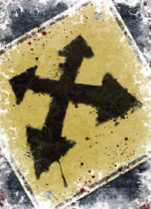
At the beginning of each player's turn, the player to her right will draw a crossroads card. That player must keep the crossroads card secret, only revealing it if its trigger happens.
The text on that card applies to the player taking a turn. If at any time on the player's turn she meets the requirements of the trigger, all of the card's text is read aloud by the player who drew it. Most crossroads cards provide 2 options to choose from, all of the text from these options is read out loud.
The player the card applies to must then choose 1 of the options. That option immediately takes effect and the card is removed from the game. If the card doesn't trigger, place it on the bottom of the crossroads deck. If a player is unable to meet the conditions of an option on a crossroads card, she must choose the other option.
Note: Some crossroads cards trigger when a player performs an action. This trigger takes place after the action being taken has been resolved.
Note: Some crossroads effects have you search a deck for a specific card. After searching a deck, shuffle it.

II. Colony Phase
During the colony phase, resolve the following 7 effects in order.
1. Pay Food
Remove 1 food token from the food supply for every 2 survivors in the colony (rounded up). Remember that helpless survivor tokens count as survivors for this purpose.
Note: Survivors at locations other than the colony do not count towards the total number of survivors in the colony. They are considered to be foraging food for themselves and so do not require food be paid from the supply.
If there are not enough food tokens do the following in order:
- Do not remove any food tokens.
- Add a starvation token to the food supply.
- Decrease morale by 1 for each starvation token currently in the food supply.
2. Check Waste
Count the cards in the waste pile. For every 10 cards (rounded down), decrease morale by 1.
3. Resolve Crisis
Shuffle the cards that were added face-down to the crisis during the player turns phase. Reveal them one at a time. Each item card added that has a symbol matching a symbol in the prevent section of the crisis is worth 1 point. Each card that doesn't have a symbol matching a symbol in the prevent section of the crisis subtracts 1 point. After revealing all of the cards, if the combined point total is lower than the number of players then immediately resolve the crisis.
If the point total equals or exceeds the number of players the crisis is prevented. Additionally, if the point total exceeds the number of players by 2 or more the colony gains 1 morale.
After resolving the crisis, remove all cards added to the crisis from the game.
4. Add Zombies
Add 1 zombie to the colony for every 2 survivors (including helpless survivors) present there (rounded up). Add 1 zombie to each non-colony location for every 1 survivor present at that location. One at a time remove each noise token at a location and roll an action die for each. Add a zombie to that location on each roll of 3 or lower (see Adding Zombies on next page for details on adding zombies to the colony).
5. Check Main Objective
Check to see if the goal on the main objective has been achieved. If it has been achieved the game immediately ends.
6. Move Round Tracker
Move the round tracker down 1 space on the round track. If it is moved onto 0 the game immediately ends.
7. Pass First Player Token
The first player passes the first player token to the player on his right. A new round begins starting with the reveal crisis section of the player turns phase.
Adding Zombies
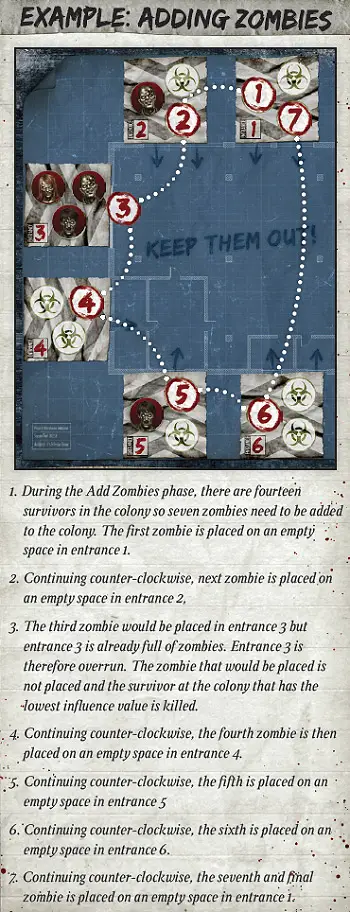
Whenever adding zombies, they are added 1 at a time until all zombies that need to be added have been added.
When adding zombies to the colony, always place the first zombie on any empty space in entrance 1, the second zombie on any empty space in entrance 2, the third zombie on any empty space in entrance 3, etc. until all of the zombies that need to be added have been placed.
When adding a seventh zombie, place it on any empty space in entrance 1 again, an eighth zombie on any empty space in entrance 2, etc. If there are no empty entrance spaces in the entrance the zombie would be placed but there is a barricade token in one of those spaces, destroy that barricade token and remove the zombie that would have been placed.
If there are no empty spaces and no barricade tokens, the entrance has been overrun, remove that zombie and kill the survivor at the colony that has the lowest influence value. If there are only helpless survivors at the colony, kill a helpless survivor. If there are no survivors at the colony remove the zombie that would have been placed without further effect. Every time a survivor is killed (including a helpless survivor), decrease morale by one.
When adding zombies to non-colony locations follow all of the same rules, except there is only 1 entrance to place zombies in so all of the zombies are placed in spaces at that entrance.
See Example: Adding Zombies to right.
In the rare case that players ever have to add zombies and there are no more zombie standees left, use the zombie tokens included in the game to add the additional zombies.
Killing Zombies
Whenever a zombie is attacked it is killed. Whenever a zombie is killed by an attack or card effect, the player that controls the survivor that killed that zombie must roll for exposure on that survivor. When killing a zombie at the colony, choose which zombie to kill. It may come from any entrance. A zombie that is killed or otherwise removed from the game board is placed back into the pile of unused zombies.
Adding Survivors
Some game effects will cause a player to add a new survivor to her following. Whenever a survivor is added to the game, its corresponding standee is added to the "Colony Occupants" section of the colony board. The player who controls the new survivor may use that survivor during her turn, but does not roll an additional action die for it until the roll action dice step of the player turns phase.
If there are no empty survivor spaces remaining at the colony, then players cannot trigger crossroads cards that would add survivors (including helpless survivors) and cannot play item cards that would add survivors.
Killing Survivors
-
When zombies overrun a location entrance a survivor is killed.
-
When a survivor has 3 or more wound tokens it is killed.
-
When a survivor is bitten it is killed.
-
Some card effects may kill a survivor.
When a survivor is killed, remove its survivor standee from the game board, decrease morale by 1, and place its survivor card in the removed from game pile. If that survivor had any cards equipped to it and that survivor is at the colony those cards are added to the hand of the player that controlled that survivor. If the survivor is at any other location those cards are shuffled into that location's item deck.
If a player's group leader is killed (or otherwise lost), she must choose a survivor from her following and make it her group leader.
If a player's last remaining survivor would be killed (or otherwise lost), that player immediately removes from the game all cards in her hand, draws a new survivor card, adds it to the game, and makes that survivor her new group leader.
If a helpless survivor is killed (by the effects of a card or as the result of a zombie overrun where there are only helpless survivors in the location), remove a helpless survivor token and reduce morale by 1.
Note: Some card effects remove survivors from the game. This is not the same thing as killing a survivor. You do not lose morale when removing a survivor unless the card directs you to.
Exile
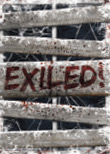
If the players vote in favor of exiling a player, the exiled player must immediately draw 1 exiled secret objective card. This card will adjust his secret objective. The exiled player must move all of the survivors he controls that are in the colony to non-colony locations of his choice. Those survivors follow all of the normal rules for movement, except this move does not count as the 1 move survivors are allowed to make during his turn. Some new rules apply to the exiled player:
-
The exiled player cannot add cards to a crisis.
-
When the exiled player is directed to add helpless survivor tokens to the colony those tokens are not added.
-
If the exiled player plays a survivor item card to add a survivor to the game it is placed at a non-colony location of his choice rather than at the colony.
-
The exiled player cannot spend food tokens to increase his action die results, but may play food cards to increase an action die result by 1 for each food card played rather than carrying out the effect listed on the food card.
-
The exiled player cannot vote.
-
The colony does not lose morale when a survivor the exiled player controls is killed.
-
When the exiled player plays a card, instead of placing it in the waste pile, he removes it from the game.
Important note: If at any time during the game there are 2 exiled players and neither had a betrayal secret objective, morale immediately drops to 0.
End of the game

When the game ends for any reason, if a player has completed his secret objective he wins. If he has not, he loses. Some players may win in a game that other players lost; there can be multiple winners. It is also possible for everyone to lose if no one has completed his secret objective when the game ends.
The game can end in a variety of ways:
-
If the morale track reaches 0 the game ends immediately. Do not check to see if the main objective has been completed.
-
If the round track reaches 0 the game ends immediately. Do not check to see if the main objective has been completed.
-
The main objective is completed.
Voting
During the game players may be given the option to vote with a thumbs up or down, either because a player initiated a vote to exile or because a crossroads card called for a vote to be cast.
Players may take time to deliberate before casting their vote. Once players are ready to vote, count down from 3, with every player simultaneously casting his vote on 0.
Card Text
When a card effect contradicts the rulebook, the card effect takes precedence. If 2 game effects would ever seem to trigger simultaneously, the first player decides in which order they will resolve. An item card cannot be played to interrupt an effect currently taking place.
Example: A medicine card cannot be played to prevent a wound, it can only be played after receiving a wound, so if a survivor receives their third wound they cannot be saved by playing a medicine card, they will be killed.
Continue Reading

Can You Draw Barricade in Your Opening Hand
Source: https://www.ultraboardgames.com/dead-of-winter/game-rules.php